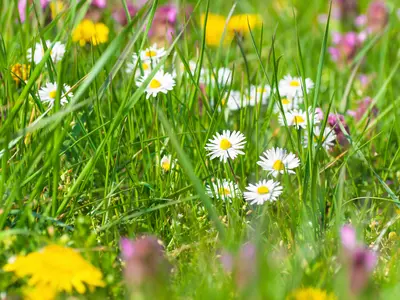
As the weather warms up and the grass starts to look shaggy, many of us automatically reach for the mower to give the lawn a trim. But wait! Leaving your lawn – or even just a part of it – unmown during the month of May can have huge benefits for pollinators and other garden wildlife. No Mow May is an initiative launched by the charity Plantlife to encourage people to mow their lawns less often, allowing pollinators to benefit from the nectar-rich flowers that appear in uncut lawns.
Common lawn wildflowers
You might think your lawn consists only of turf grasses, but if it was left to its own devices, you would be surprised at how many different plants would appear. Here are a few of the plants that flourish in unmown lawns:
- Dandelions – a great source of pollen and nectar for pollen beetles, bees, hoverflies and butterflies in early spring
- Buttercups – popular with short-tongued bees
- Daisies – nectar and pollen for small bees and beetles
- Germander speedwell – the pretty blue flowers are very popular with solitary bees
- White clover – especially good for honey bees, and also popular with butterflies
- Selfheal – the purple flowers provide food for bees and wasps
- Birds foot trefoil – another popular food source for bees
Other plants that have appeared in people’s gardens during No Mow May include wild garlic, meadow saxifrage, snakes head fritillaries, eyebright and even some of our native orchids! These wildflowers are a fantastic food source for pollinators, which are vital for our gardens and for the wider ecosystem.
Why mowing less is good for wildlife
Mowing your lawn less often allows plants like clover, selfheal and daisies to produce more flowers. Each time you mow, any flowers that have been produced get chopped off by the lawnmower blades, but the low-growing leaves remain. Mowing less frequently allows these plants more time to flower, and when you do mow, cutting off the flowers triggers the plants to produce more, prolonging the flowering season and providing more food for pollinators. Long grass is also a good habitat for spiders and other invertebrates that help to keep our garden ecosystems in balance.
Mow less often in May
No Mow May is one of the easiest ways to help your garden wildlife. Just leave your lawnmower in the shed for a month and put your feet up! However, if you love a freshly-cut lawn, you don’t have to stop mowing entirely. Simply reduce your mowing frequency, for example, mowing fortnightly instead of weekly, and if you have space, leave a few areas of grass to grow long. Even a small patch of unmown lawn will provide a habitat for insects and invertebrates, and food for pollinators. So give your lawnmower a rest this month and let the wildlife enjoy your lawn instead!
Want to make your garden even more wildlife-friendly? You’ll find everything you need in our centre, from pollinator-friendly plants to birdcare products, so come in and see us!
